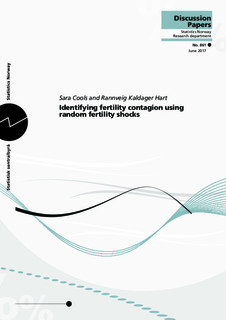| dc.contributor.author | Cools, Sara | |
| dc.contributor.author | Kaldager, Rannveig Hart | |
| dc.date.accessioned | 2018-01-16T11:48:51Z | |
| dc.date.available | 2018-01-16T11:48:51Z | |
| dc.date.issued | 2017-06-13 | |
| dc.identifier.issn | 1892-753X | |
| dc.identifier.uri | http://hdl.handle.net/11250/2477755 | |
| dc.description.abstract | Does the fertility behavior of one individual affect the fertility choices of another? This study aims to estimate fertility contagion net of unobserved heterogeneity, using sibling networks as an empirical example.
Fertility contagion through social networks increasingly attracts the interest of demographers. While these theories propose a causal mechanism, they are rarely put to test in a plausibly causal statistical design. This study applies quasi experimental techniques to distinguish network effects from selection. Using contagion between siblings as an empirical example, we draw data from Norwegian administrative registers (N approx.170 000 men and women). We use twin births and the sex composition of children as random fertility shocks. We find no consistent significant effects of random shocks to a sibling's fertility on ego's fertility. First born women have larger families over time if a younger sibling chooses to have three children, as captured by the same sex instrument. We find no evidence that similarity strengthens contagion. | nb_NO |
| dc.language.iso | eng | nb_NO |
| dc.publisher | Statistics Norway, Research department | nb_NO |
| dc.relation.ispartofseries | Discussion Papers;No. 861 | |
| dc.subject | Fertilitet | nb_NO |
| dc.subject | Fruktbarhet | nb_NO |
| dc.subject | Familierelasjoner | nb_NO |
| dc.title | Identifying fertility contagion using random fertility shocks | nb_NO |
| dc.type | Working paper | nb_NO |
| dc.subject.nsi | VDP::Samfunnsvitenskap: 200::Kvinne- og kjønnsstudier: 370 | nb_NO |
| dc.source.pagenumber | 24 s. | nb_NO |
